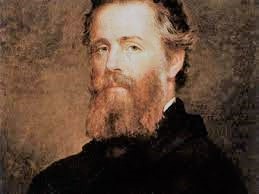|
Getting your Trinity Audio player ready...
|
Herman Melville was an American Short story writer, Novelist, and Poet. He worked with his writing during the American Renaissance period. He started his career by working as a crew member in 1839.
His successful work experiences motivate him to write novels and books. In 1846, he published his first successful novel Typee and in 1847 he published Omoo. His books also gained popularity like Moby-Dick in 1851.
Later in the 1860s, Herman Melville turned to poetry. Each of his works left a great impact on the readers. It is said that his real-life struggles can be sensed in his writings.
To know the secret behind his writing, let’s take a look at his early life of Melville and the circumstances that motivated him to begin writing Poetry and Novels.
Melville Early Life
Herman was born in New York City on 1st August 1819 to Allan and Maria Gansevoort Melvill. Young Herman fell ill because of scarlet fever in the mid-1820s. He gained some health but was not perfectly fine.
His vision was left impaired permanently because of the illness. However, the family had enjoyed a prosperous life for a long time due to Allan’s success as a merchant and high-end importer. For better revenue, Allan borrows huge amounts of money.
He also tried to move his family to a better state but the high-interest rate turned things on the bad side. Furthermore, the family situation got worse when Allen suddenly died in 1932. The overall finance of the family dwindled significantly.
Being the oldest son of Allen, Gansevoort took control of the fur and cap business of the family in New York after his father’s death. At the same time, Herman Melville gets a job as a Clerk at a bank to help the family and fulfill their basic needs.
Later during the 1830s, Melville was enrolled at Albany Academy and Albany Classical School. Here he studied classic literature and started writing short stories, essays, and poems. In the year 1837, Melville left Albany for a teaching job in Massachusetts but did not get satisfied with the job and returned to New York soon.
This year, Gansevoort’s fur and cap business folded, putting Melville back into a critical financial situation. The family relocated to Mansinburgh, New York. Furthermore, Melville enrolled at Lansingburgh Academy to study surveying so that he can gain employment with the newly initiated Erie Canal project.
Early Writing Success
Melville tried a lot to get a coveted job to support his family but was unable to do so. That’s why he followed Gansevroot’s suggestion to work as a crew member on a boat. He signed on as a boy in 1839 as a cabin boy for a merchant ship called St. Lawrence.
The ship traveled from New York City to Liverpool, England, and back. Later in 1841, after being hired to work aboard the Acushnet (a whaling ship), Herman Melville embarked on his second sea voyage.
His continued wild journey provided the sparks for his yet-to-be-realized literary career. In 1842, Melville arrived at the Marquesas Islands of Polynesia. Here he and his crewmate deserted the ship and within a short timespan were captured by local cannibals.
Although Herman was treated well, he escaped after 4 months on board another whaling ship called Lucy Ann. He was jailed after joining the crew in a mutiny. Melville eventually wound up in Hawaii before catching a ride back to Massachusetts on the USS United States.
Because of all this mishap, Melville returned home after more than 3 years. He immediately sat down and grabbed a pen to paper to capture his experiences. His book Typee: A Peep at Polynesian Life – 1846 is a combination of his tales and fictional events.
He drew attention to his seafaring life by explaining everything in detail and adding a seemingly too-wild-to-believe plot. In the year 1847, Herman Melville came up with an equally successful sequel called Omoo: A Narrative of Adventures in the South Seas.
In addition to that, here is a list of some amazing books by Herman Melville.
- Omoo – 1847
- Redburn – 1849
- White Jacket – 1850
- Moby-Dick – 1851
- The Encantadas – 1854
- Benito Cereno – 1855
- The Piazza Tales – 1856
- The Confidence-Man – 1857
- Billy Bud – 1924 and much more

